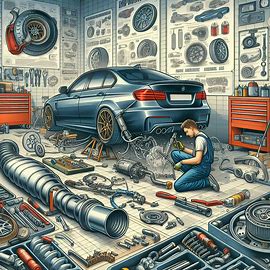
Introduction
Most drivers assume the exhaust is just a metal pipe that pushes out smoke. But that’s far from the truth. Your vehicle’s exhaust system plays a vital role in overall performance. It manages airflow, maintains fuel efficiency, reduces harmful emissions, and even influences engine output. When optimized, it becomes a key performance enhancer—not just a source of sweet sound.
Upgrading your exhaust system for more power isn’t just about volume. It’s about enhancing exhaust flow, reducing restrictions, and unlocking your engine’s true potential. Whether you’re driving a turbocharged beast or a naturally aspirated daily driver, a well-thought-out exhaust upgrade can bring noticeable gains in horsepower, torque, and throttle response—all while delivering that deep, growling tone gearheads live for.
What Is an Exhaust System and What Does It Do?
An exhaust system is a network of pipes and components that channels gases produced by your engine safely out of the vehicle. But it’s not just about removing gases—it’s about doing it efficiently. Key components include:
-
Exhaust manifold or headers: Connect to the engine and collect exhaust gases.
-
Catalytic converter: Converts harmful pollutants into less harmful emissions.
-
Resonator: Fine-tunes sound and smooths exhaust flow.
-
Muffler: Reduces noise.
-
Tailpipe: The final exit point for exhaust gases.
Every bend, joint, and restriction in this system affects how quickly gases can escape. Faster flow = more efficient engine cycles = more power.
Stock vs Aftermarket Exhaust Systems
Factory exhaust systems are built for one thing: compromise. Automakers must balance noise regulations, emissions standards, cost, and comfort. That usually means using narrow pipes, restrictive catalytic converters, and mufflers that kill sound and flow.
Aftermarket systems, on the other hand, prioritize performance. They’re designed to:
-
Increase pipe diameter for improved flow
-
Use smoother bends (mandrel vs crush)
-
Reduce backpressure
-
Use less restrictive mufflers and cats
The difference isn’t just audible—it’s measurable.
Signs Your Exhaust Is Restricting Performance
You might be leaving horsepower on the table without even knowing it. Here are some red flags that your stock exhaust is holding your engine back:
-
Throttle feels delayed or sluggish
-
RPMs build slowly under hard acceleration
-
Noticeable drop in power at high speeds
-
Weak or muted engine note
-
Reduced fuel economy despite careful driving
If your engine’s working hard but feels choked, your exhaust system might be the bottleneck.
How an Upgraded Exhaust Adds Power
It’s all about airflow. When your engine breathes in air (via intake) and breathes out gases (via exhaust), any restriction in this process reduces efficiency. A performance exhaust reduces these restrictions, allowing gases to exit faster and with less resistance.
Here’s how that translates into power:
-
Less backpressure: Easier gas evacuation means quicker combustion cycles.
-
Improved scavenging: Exhaust pulses help pull the next one along, boosting flow.
-
Enhanced throttle response: Especially noticeable at higher RPMs.
Horsepower gains can range from 5-10 HP for axle-back systems to 20+ HP for full header-back setups with proper tuning.
The Science of Exhaust Flow and Backpressure
A common myth is that some backpressure is necessary. Truth is, engines benefit from velocity, not pressure. What matters is maintaining consistent, high-speed flow of exhaust gases, especially in performance setups.
Backpressure slows gases down, causes heat buildup, and can lead to inefficient combustion. Your goal with an upgraded system is to maintain high flow rates without sacrificing exhaust scavenging—a delicate balance that high-performance components are designed to maintain.
Cat-Back vs Axle-Back vs Header-Back
Cat-Back System:
-
Replaces everything from the catalytic converter to the tailpipe.
-
Gains: moderate power, noticeable sound.
-
Ideal for daily drivers.
Axle-Back System:
-
Replaces components after the rear axle—mostly just the muffler and tips.
-
Gains: sound improvement, slight performance.
-
Great budget upgrade.
Header-Back System:
-
Replaces the entire exhaust, including headers.
-
Gains: maximum performance.
-
Best for track cars or heavy tuners.
Straight Pipe vs Performance Muffler
Straight Pipes:
-
Zero restrictions = maximum flow and sound.
-
BUT: Illegal in many regions, causes extreme noise, may cause power loss in low RPMs.
Performance Mufflers:
-
Engineered to reduce sound without restricting flow.
-
Provide a deep, aggressive tone with power gains.
Unless you’re building a full race car, performance mufflers are the smart move.
Resonators: Should You Delete Them?
Resonators remove certain frequencies to reduce drone and cabin noise. Deleting them makes your exhaust louder, but sometimes worse sounding.
Should you delete? Only if:
-
You’re fine with added interior noise
-
You like a raspy tone
-
You’re already upgrading the rest of the system
Otherwise, a resonated setup offers the best balance of power, tone, and daily comfort.